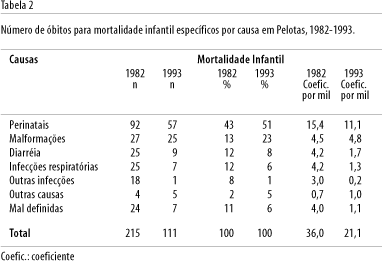Time trends in infant mortality were assessed through two cohort studies carried out in Pelotas, Southern Brazil, in 1982 and 1993. Both cohorts included all hospital deliveries, and deaths were monitored through regular visits to hospitals, cemeteries, and notary publics. Information on cause of death was obtained from pediatricians, case notes, autopsies, and home visits to parents. The infant mortality rate fell from 36.4 in 1982 to 21.1 per thousand live births in 1993. The main causes of death in 1993 were perinatal, congenital malformations, diarrhea, and respiratory infections. Low birthweight babies were twelve times more likely to die than the others. The death rate among preterm babies was 2.0 times greater than for those with intrauterine growth retardation. Mortality among children whose families earned less than one minimum wage was almost seven times greater than for those with a family income of more than ten times the monthly minimum wage. Mortality for low birthweight babies from high-income families decreased by 67%, as compared to only 36% for those from low-income families. Thus, although mortality decreased substantially over the course of the decade, wide social differentials have persisted.
Infant Mortality; Birthweight; Family Income; Pediatric Intensive Care Unit; Epidemiology







